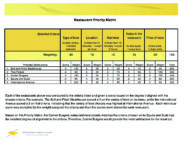


RICE scores don’t take dependencies into account.This shifts the prioritization discussions from “Here’s how much this feature is worth“ to “Here is how we are quantifying our level of confidence for each of these qualitative, speculative scores.” By adding a confidence dimension in the calculations, prioritization moves away from attempting to predict success to measuring the level of assertion each team member has for the features. It lessens the influence that inherent biases have on prioritization.SMART stands for specific, measurable, attainable, relevant and-as seen in the parameter for the Reach score-time-based. It requires that product teams make their product metrics SMART before they quantify them.You can then use that final score to rank the order in which you’ll tackle the idea, initiative or feature. This formula gives product teams a standardized number that can be applied across any type of initiative that needs to be added to the roadmap.Īfter running each feature by this calculation, you’ll get a final RICE score. Then, those individual numbers get turned into one overall score using a formula. Here’s a breakdown of what each factor stands for and how it should be quantified: This scoring system measures each feature or initiative against four factors: reach, impact, confidence and effort (hence the acronym RICE). Known as Intercom's internal scoring system for prioritizing ideas, RICE allows product teams to work on the initiatives that are most likely to impact any given goal. We’ll guide you through those two frameworks, plus: That’s why we offer two built-in prioritization frameworks in our feedback and idea management suite: RICE and value vs. Ideally, good product prioritization frameworks allow you to silence the voice of the loudest person in the room using quantitative rankings, charts, and matrices with values that are directly tied to your customer feedback and product strategy. Bruce McCarthy, Product Manager and author of Roadmaps Relaunched That's a complex problem of finding the overlap in multiple different areas, not to mention things that a team can reasonably do technologically.” You've got to have a deliberate strategy where you go: We have a particular type of customer that we're trying to serve and we are trying to solve their biggest problems in a way that makes us money. "The most popular feature and the second most popular feature don't necessarily belong together in the same product. Narrowing that list of demands and feature requests for a sprint or a product roadmap is one of the most challenging parts of a product manager’s job.Īnother prioritization challenge product managers face is knowing how many team members, stakeholders and customers they should involve, and to what degree they should vote on which features, tasks and updates you’ll work on next. Product prioritization isn’t just about making a stack of features in a certain order-it also involves juggling the many inputs and opinions of stakeholders. Get the latest insights on product management and roadmapping trends.Īn original product management podcast for / by product people.Ī collection of resources to help you master Roadmunk, from the ground up.Ī collection of in-depth documentation on all things Roadmunk.Ĭonnect with one of our product specialists about all things Roadmunk. Read our In depth guides on all things planning, prioritizing and roadmapping. Roadmunk takes security seriously so you can rest assured your data is safe. Sync your roadmapping data with the tools your team uses to get work done. Capture customer feedback, prioritize product ideas, and use roadmaps to communicate your strategy.Ĭonnect your high-level strategy with daily planning by syncing your data between Roadmunk and Jira.Įasily synchronize work items and field data into a strategic roadmap.


 0 kommentar(er)
0 kommentar(er)
